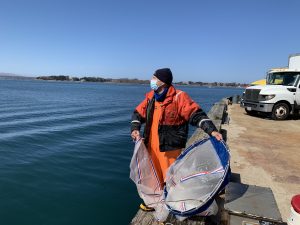Neighborhood watch (plankton style)
I’ve been snooping around in our zooplankton “neighborhood.” I’m really interested in how planktonic animals use dormancy to adapt to variable environments. Some copepods, like Acartia tonsa modify their reproductive strategy depending on environmental conditions. Acartia moms can either produce eggs that are ready to hatch, or they can produce dormant eggs. This decision is usually made in response to the water temperature and day length. But we don’t really understand how the animal uses these external signals to regulate its biology.
Based on a variety of studies in other labs, I suspect that our local Acartia tonsa stock changes over the course of the season…so it’s not really all one stock, but rather a mixture of animals that are adapted to specific seasonal conditions. My goal this summer is to detect these different stocks using genetic methods. I then hope to study how the conditions associated with producing dormant eggs vary among stocks. THEN…I hope to investigate how those different traits are regulated (I have some hypotheses!).
I’m just at the start of this journey…learning how to collect, identify, amplify, culture these critters, but I’m exciting to see how it goes. It’s been fun so far…I’ve been collecting plankton off our local dock every two weeks since late March. The photo shows Phil Alatalo casting the net on our first sampling trip (Phil very generously helped me get set up with equipment and showed me the ‘ropes’ of sampling off the dock). It feels good to finally be getting back into the field, even if I’m not going very far!